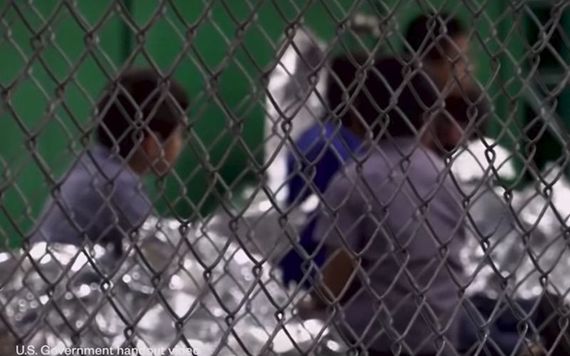Neither Ireland nor the rest of Europe is in any position to lecture Trump on his immigration policy.
There was an outpouring of appalled comment in Ireland last week on President Trump’s order —now reversed—to begin separating children from migrant parents who had been caught illegally entering the U.S. over the Mexican border. And there was the same horrified outcry across Europe.
But the truth behind all the outrage is that Ireland, like the rest of Europe, is much closer to Trump's determination to tackle illegal immigration than you might think.
Of course, people here were appalled at Trump's action, and rightly so. It was a brutal, heartless way of sending a message to migrant families contemplating illegal entry. And it was stupid since legally it was never going to be sustainable (unless you think Trump always knew it could only be a temporary action).
All the highly emotive reporting enraged people here. We were told about kids being "torn" from their mothers and put in "cages." The same pictures of one wire-fenced enclosure were used across the media.
Read more: Outrage at US treatment of child migrants puts spotlight on how Ireland treats asylum-seekers
But when reporters from leading U.S. papers went looking for "cages" they could not find any. We know now that although some kids were briefly put in a fenced off holding area, they were then transferred to the normal state facilities that deal with children.
One emotive picture, the one of the little girl sobbing as she looked up at her mother who had been detained, went around the world and was used in all the Irish papers. The impression given was that the little girl was in the process of being separated from her mother.

Except that we now know that the child had been put down briefly by her mother while she was being searched and they were never separated; they were transferred to a holding facility together. This same image was cropped and used to produce the misleading Time magazine cover which showed Trump looking down at the child, with the headline “Welcome to America.”
It was much the same across the media where there were repeated references to cages and similarities with Nazi concentration camps. No one seemed to care the way this reflected on the Department of Homeland Security and other staff who were doing their best to be caring in a very difficult situation.
Of course, the policy should never have been implemented. It has involved trauma for over 2,000 children and minors who were separated, with many moved to facilities in other states. Although reunification is now underway, the serious hurt was inflicted.
The problem is that under U.S. law there was no alternative if the parents are to be detained for a lengthy period while awaiting a hearing. Under the 1997 Flores ruling, children cannot be held in detention for more than 20 days, even if they are with their parents.
Since such cases typically take many months to be heard, the practice up to now has been to release these families, who then disappear to live in America illegally. This has been going on for years and it is natural that migrant families have made use of the loophole.
Migrants have also learned always to ask for asylum on the basis that they are fleeing violence rather than poverty. The truth is that even in countries like gang-plagued Honduras it is the desire for a better life that is the primary reason most of them want to get into the U.S. (otherwise they would stay in Mexico).

Rightly or wrongly, Trump has decided that he is going to stop all this and put in place an effective system to control immigration into the U.S. As he keeps saying, this will involve a complete reform of the system, something that has been dodged by Congress and previous presidents for years. Despite a lot of lip service, nothing was done.
From an Irish and European perspective, what is striking is the similarity between the situation on opposite sides of the Atlantic. In the U.S. it's dealing with migration from Central America; over here it's dealing with migration from North Africa.
Trump senses that many people in the U.S. (including many of those appalled at his separation move) want effective action on the issue. Over here politicians across Europe this week were grappling with the migration issue at a summit meeting, knowing that their voters are losing patience with them.
The difficulty is that no one has an answer, apart from strengthening borders. The U.S. cannot take in an unlimited number of migrants from Central America, just as Europe cannot take in an unlimited number of migrants from Africa.
Read more: Immigration, JFK Vs Trump, welcome or go home
If anything, the situation in Europe along the Mediterranean coast is even worse than along the U.S. border and there is just as much trauma involved, particularly for children. There may not be separation, but in some arrival countries families are held in wire-fenced enclosures for lengthy periods in miserable conditions. No one has clean hands on this, including Ireland, where we are failing to live up to promises we made on accepting migrants.
As part of the last EU wide agreement a few years ago we were supposed to take in 4,000 migrants to relieve pressure in these holding camps in Greece and Italy. So far we have taken very few (last year it was a few hundred) and even doing that much has not been easy. They have been put mainly into underused hotels in provincial towns with no advance consultation with the local people to avoid objections.
Migration to Europe had been building quietly for years, but it really took off in 2015 when German Chancellor Angela Merkel said she would accept all asylum seekers from the war in Syria who could get to Germany. Over a million arrived.

WikiCommons
Despite their best efforts to be welcoming, Germans since then have struggled with the problems it caused, not least because so many of the arrivals were young men from a very different cultural background and many were not Syrian.
It also created first the overland route through Turkey and Greece and then (when borders in Hungary and other countries on the route were closed) the migrant traffic across the Mediterranean. It also created a whole industry of people smugglers after the word spread across Africa that getting into Europe was possible.
The result of this is that economic migrants now come from all over Africa (and even some countries in Asia) rather than from conflict areas in North Africa like Syria. This is evident all the time in pictures from the Mediterranean where the inflatable boats that are used by the smugglers are packed almost entirely with young men from sub-Saharan Africa.
Read more: What you can do to tackle Trump’s zero-tolerance immigration policy
Another aspect to all this is that these young male migrants are not the wretched, impoverished refugees stuck in the huge refugee camps in Lebanon and Jordan. (Jordan, which has a smaller population than Ireland, has taken in over a million migrants from Syria.)
The migrants crossing the Med are those who can afford to pay the smugglers a thousand dollars a head for a place in a boat. All of the agonizing in Europe at the plight of migrants on the Med ignores the real suffering which is the everyday life of the millions in the refugee camps.
This is one factor, as well as the overall concern about the numbers and cultural differences, which has changed opinion in Europe. There is a growing opinion that the problem must be solved in the countries of origin rather than by mass migration into Europe.
This shift in opinion is now forcing political leaders in Europe to take a much tougher approach on migration. Failure to do so will result in even more hardline parties winning power in European countries and could even cost Merkel her leadership in Germany.
So despite all the criticism in Europe of Trump, both sides are essentially doing the same thing, trying to stop the uncontrolled illegal migrant flow across their borders.
Just as in Europe, Trump is responding to voters and unless Democrats wake up to this and facilitate real immigration reform they will again pay the price. All the media hysteria, in Ireland and elsewhere, does not change the wider reality.
Shameful though it was, Trump's now reversed action on separation was a signal to the electorate that he is going to take action on this difficult issue. And neither Ireland nor the rest of Europe is in any position to lecture him.
Do you think Ireland can criticize Trump? Let us know your thoughts in the comments section, below.




Comments